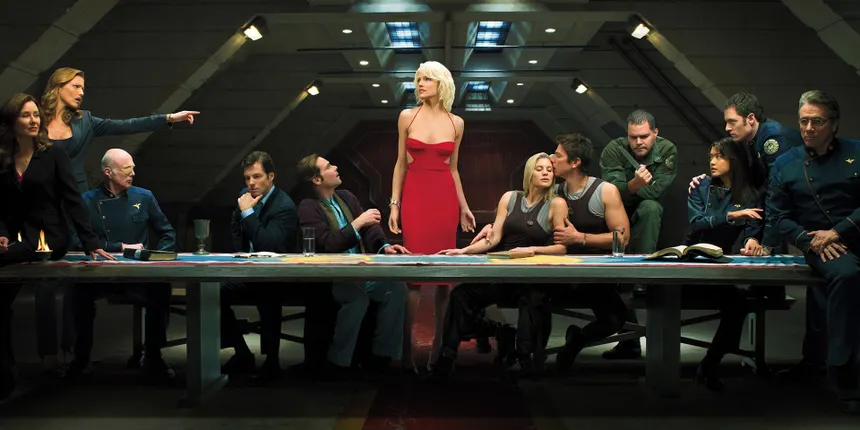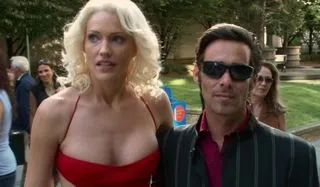Few mysteries in Battlestar Galactica (2004) have sparked as much debate as the so-called “Head” characters—those enigmatic, spectral figures appearing only to specific individuals. Most notably, we see “Head Six” guiding (or manipulating) Gaius Baltar and “Head Baltar” doing the same for Caprica-Six. They possess knowledge beyond their hosts’ understanding, push them toward actions that shape the fate of humanity and Cylons alike, and disappear just as mysteriously as they arrive. The Head avatars in BSG raise the question: what are they? Angels, hallucinations, Cylon projections, or something else entirely? The show never explicitly states their nature, but let’s break down the theories and what they mean for Battlestar Galactica‘s larger themes.

The Divine Messenger Theory of the Head Avatars
Throughout the series, the “Head” avatars frequently reference God and divine purpose. In season two, Head Six tells Baltar that “God has a plan” and insists that everything is unfolding as it should. Later, in the final episodes, the avatars reappear thousands of years in the future, walking through modern-day Earth, discussing the cyclical nature of history. This heavily implies they exist beyond time and space.
If they are divine messengers, their purpose is to guide humanity and the Cylons toward a resolution that breaks the cycle of war and destruction. Their actions seem aligned with this goal—Baltar and Six ultimately influence the decision to abandon advanced technology, leaving the surviving fleet to start anew on a prehistoric Earth. This theory aligns with BSG’s overarching exploration of faith, destiny, and the unknown. However, the series never outright confirms that these entities are literal angels, leaving room for interpretation.
The Cylon Projection Theory of the Head Avatars
A more technological explanation is that the “Head” characters are a form of Cylon projection—an ability Cylons have to manipulate their perception of reality. Throughout the series, we see Cylons use projection to alter their surroundings or communicate with others in ways humans can’t.
If the “Head” entities are a form of advanced projection, they could be remnants of an ancient Cylon consciousness, influencing key individuals to ensure the survival of both humans and Cylons. However, this theory doesn’t fully explain why Baltar—who is fully human—experiences these visions or why they persist beyond the fall of the Cylons.
The Hallucination or Psychological Projection Theory
Another possibility is that the “Head” avatars are nothing more than hallucinations—manifestations of guilt, ambition, or subconscious insight. Baltar’s visions of Six could be his mind’s way of dealing with his role in the fall of the Twelve Colonies, just as Caprica-Six’s visions of Baltar may represent her struggles with morality and love.
However, this theory has significant flaws. The “Head” avatars know things their hosts do not. They predict events, influence reality in tangible ways, and appear to multiple individuals in different circumstances. A prime example is in Daybreak, when Head Six and Head Baltar appear in the distant future, still discussing the fate of humanity. If they were mere hallucinations, how could they persist beyond their hosts’ lifetimes?
Beings Outside of Time
The final and perhaps most intriguing theory is that the “Head” avatars are beings beyond human or Cylon understanding—entities existing outside normal space-time. This would explain their ability to foresee the future, their knowledge of past events, and their continued presence beyond the main events of the series.
This idea fits well with Battlestar Galactica‘s broader themes. The show repeatedly explores the idea of cycles—war, destruction, rebirth. Perhaps the “Head” avatars exist to subtly nudge key individuals in the right direction, preventing total annihilation and ensuring that some form of humanity survives. Their cryptic nature adds to the mystery, leaving viewers to decide whether they represent divine intervention, advanced intelligence, or something beyond human comprehension.
The Genius of Ambiguity
Ronald D. Moore, the creator of the BSG reboot, deliberately avoided providing a clear answer about the nature of the “Head” avatars. This was a conscious decision that aligns with the show’s commitment to exploring faith, free will, and the unknown. While some fans may find this lack of explanation frustrating, it allows for personal interpretation—just as in real-life debates about fate versus free will, science versus religion.
Ultimately, the “Head” characters serve as a narrative bridge between belief and skepticism, between determinism and chaos. Whether divine or not, their presence in the series challenges both the characters and the audience to consider the possibility that there are forces at work beyond our understanding.
Conclusion
The mystery of the “Head” avatars remains one of the most fascinating aspects of Battlestar Galactica. Whether you view them as angels, AI projections, or something else entirely, their influence on the story is undeniable. They shape the destinies of Gaius Baltar and Caprica-Six, steer the remnants of humanity toward their final fate, and leave us pondering one of BSG‘s greatest questions: Do we control our own fate, or is there always a guiding hand, unseen and unknowable?

